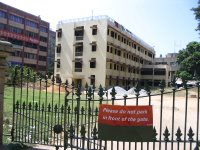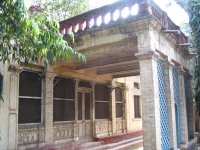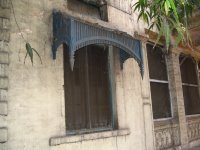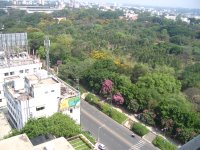Bangalore Walks
At a dinner party given recently by an OWC friend, Jay learned about a native Bangalorian who
 gives walks around town. We signed up for the History Tour, paid our rupees online and met our guide Arun at Holy Trinity Church at the foot of M.G. (Mahatma Gandhi) Road on Sunday morning at 7:00. There were two other “walkers” with us; a young woman from east Africa and a young man from Germany.
gives walks around town. We signed up for the History Tour, paid our rupees online and met our guide Arun at Holy Trinity Church at the foot of M.G. (Mahatma Gandhi) Road on Sunday morning at 7:00. There were two other “walkers” with us; a young woman from east Africa and a young man from Germany.We began with a tour of the inside of Holy Trinity Church. It
 was the second church (after St. Mark’s) built by the British for the military forces in B’lore, circa 1850. Inside were many plaques commemorating fallen comrades. There were a variety of reasons for their untimely deaths; some died of disease, some drowned, one died of wounds inflicted by a tiger. After walking around in the
was the second church (after St. Mark’s) built by the British for the military forces in B’lore, circa 1850. Inside were many plaques commemorating fallen comrades. There were a variety of reasons for their untimely deaths; some died of disease, some drowned, one died of wounds inflicted by a tiger. After walking around in the  sanctuary, we
sanctuary, we  were allowed to climb four flights of extremely steep steps to reach the top of the bell tower. From there we could look down MG Road and see the main government building about three kilometers away. What a sight!
were allowed to climb four flights of extremely steep steps to reach the top of the bell tower. From there we could look down MG Road and see the main government building about three kilometers away. What a sight! As we strolled down MG Road, Arun told us about several prominent people who had lived there. Probably the most famous was Winston Churchill. The house where he lived is no longer there, but the lot behind the metal fencing is where his house once stood.
As we strolled down MG Road, Arun told us about several prominent people who had lived there. Probably the most famous was Winston Churchill. The house where he lived is no longer there, but the lot behind the metal fencing is where his house once stood.We were delighted to discover that there was a lovely stone house, built in the 1920’s or 30’s, that sat at the end of a long driveway, hidden behind two office buildings. At the time the house
 was built it was the custom for wealthy people to have large front gardens. The grandson of the man who built the house lives there today. The family was cash poor and land rich and since the real estate on the most famous road in Bangalore was going for very high prices, they sold off the road frontage. They still have a lovely, private front yard with a circle drive in front.
was built it was the custom for wealthy people to have large front gardens. The grandson of the man who built the house lives there today. The family was cash poor and land rich and since the real estate on the most famous road in Bangalore was going for very high prices, they sold off the road frontage. They still have a lovely, private front yard with a circle drive in front.Another stone house along MG Road is abandoned. There is currently a heated dispute about
 who owns the property. There’s no telling when that will be settled. In the meantime, Arun was given permission to bring people by to look at two architectural features of the house. First, it has a carriage canopy (a covered porch with steps that begin about two feet off the ground for
who owns the property. There’s no telling when that will be settled. In the meantime, Arun was given permission to bring people by to look at two architectural features of the house. First, it has a carriage canopy (a covered porch with steps that begin about two feet off the ground for  alighting from a carriage and going directly into the house) and secondly, the windows had monkey tops. These little awnings were extremely popular in bygone days. There are two versions of why they’re called monkey tops. The first said that if windows had these tops monkeys wouldn’t try to get in the windows. The second version is that monkeys sat on top of these little perches. Either way, they’re cute! Each house’s monkey tops were custom made, so they were unique.
alighting from a carriage and going directly into the house) and secondly, the windows had monkey tops. These little awnings were extremely popular in bygone days. There are two versions of why they’re called monkey tops. The first said that if windows had these tops monkeys wouldn’t try to get in the windows. The second version is that monkeys sat on top of these little perches. Either way, they’re cute! Each house’s monkey tops were custom made, so they were unique.
In a green space we passed is the only statue of a German in India. Dr. Kittel (holding a German flag) translated the dictionary into Kannada, the local language. Quite a feat.
There were also several government buildings, another church and the first power plant built in B'lore along the way.
Our tour ended 400 yards west from the beginning at the top of the Barton Center
 . We were able to get a grand view of the city from that vantage point. Bangalore is quite a green city, much like Atlanta. We discovered the Ebony Restaurant on the 13th floor serves a Sunday morning buffet, but we decided to save that for another day.
. We were able to get a grand view of the city from that vantage point. Bangalore is quite a green city, much like Atlanta. We discovered the Ebony Restaurant on the 13th floor serves a Sunday morning buffet, but we decided to save that for another day.

0 Comments:
Post a Comment
<< Home